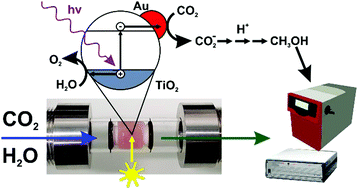当前位置:
X-MOL 学术
›
Mater. Horiz.
›
论文详情
Our official English website, www.x-mol.net, welcomes your feedback! (Note: you will need to create a separate account there.)
Translucent nanoparticle-based aerogel monoliths as 3-dimensional photocatalysts for the selective photoreduction of CO2 to methanol in a continuous flow reactor
Materials Horizons ( IF 13.3 ) Pub Date : 2017-09-05 00:00:00 , DOI: 10.1039/c7mh00423k Felix Rechberger 1, 2, 3, 4 , Markus Niederberger 1, 2, 3, 4
Materials Horizons ( IF 13.3 ) Pub Date : 2017-09-05 00:00:00 , DOI: 10.1039/c7mh00423k Felix Rechberger 1, 2, 3, 4 , Markus Niederberger 1, 2, 3, 4
Affiliation

|
The selective photoreduction of CO2 to methanol is an energy efficient way to transform a harmful greenhouse gas into a hydrocarbon of great industrial importance. However, the search for efficient photocatalysts able to reduce CO2 with water turned out to be extremely challenging. Besides studying new materials compositions and combinations, architectural design involving the structuring of catalysts from the nanometer to the centimetre scale and over three dimensions represents a much less studied, but nevertheless highly promising approach for the development of new photocatalysts. Translucent nanoparticle-based aerogels with their large surface areas, high porosity, well-developed crystallinity, multiscale structural features and their excellent light absorption properties offer all the advantages of a successful photocatalyst. Unfortunately, the mechanical fragility strongly limited their use in monolithic form. Here we present a prototype of a flow reactor, which enables the direct exploitation of cylindrical aerogel monoliths in various gas phase reactions. In particular, we studied the performance of TiO2–Au nanoparticle based aerogels for the photoreduction of CO2 with water to methanol, resulting in a conversion rate of 2.58 μmol g−1 h−1 with high selectivity. The assembly of nanoparticles into three-dimensional macroscopic bodies, which can directly be introduced in a flow reactor, opens up unique opportunities for the development of new and efficient photocatalysts beyond powders and films for a wide range of gas phase reactions.
中文翻译:

基于半透明纳米颗粒的气凝胶整体材料,作为三维光催化剂,用于在连续流反应器中将CO 2选择性光还原为甲醇
将CO 2选择性光还原为甲醇是一种将有害温室气体转化为具有重要工业意义的碳氢化合物的节能方式。然而,寻求能够减少CO 2的有效光催化剂用水证明是极具挑战性的。除了研究新材料的成分和组合之外,涉及从纳米尺度到厘米尺度以及超过三个维度的催化剂结构的建筑设计也代表着研究不足,但是对于开发新的光催化剂而言仍然是非常有前途的方法。半透明的基于纳米颗粒的气凝胶具有大的表面积,高孔隙率,良好的结晶度,多尺度的结构特征以及出色的光吸收特性,这些都是成功的光催化剂的所有优点。不幸的是,机械脆性极大地限制了它们以整体形式使用。在这里,我们介绍了一种流动反应器的原型,该原型可以在各种气相反应中直接利用圆柱形气凝胶整体材料。基于2 Au纳米颗粒的气凝胶,可将CO 2用水光还原为甲醇,从而以高选择性实现2.58μmolg -1 h -1的转化率。将纳米颗粒组装成三维宏观物体,可以将其直接引入到流动反应器中,这为开发新型和有效的光催化剂提供了独特的机会,这些催化剂不仅适用于粉末和薄膜,而且适用于多种气相反应。
更新日期:2017-10-30
中文翻译:

基于半透明纳米颗粒的气凝胶整体材料,作为三维光催化剂,用于在连续流反应器中将CO 2选择性光还原为甲醇
将CO 2选择性光还原为甲醇是一种将有害温室气体转化为具有重要工业意义的碳氢化合物的节能方式。然而,寻求能够减少CO 2的有效光催化剂用水证明是极具挑战性的。除了研究新材料的成分和组合之外,涉及从纳米尺度到厘米尺度以及超过三个维度的催化剂结构的建筑设计也代表着研究不足,但是对于开发新的光催化剂而言仍然是非常有前途的方法。半透明的基于纳米颗粒的气凝胶具有大的表面积,高孔隙率,良好的结晶度,多尺度的结构特征以及出色的光吸收特性,这些都是成功的光催化剂的所有优点。不幸的是,机械脆性极大地限制了它们以整体形式使用。在这里,我们介绍了一种流动反应器的原型,该原型可以在各种气相反应中直接利用圆柱形气凝胶整体材料。基于2 Au纳米颗粒的气凝胶,可将CO 2用水光还原为甲醇,从而以高选择性实现2.58μmolg -1 h -1的转化率。将纳米颗粒组装成三维宏观物体,可以将其直接引入到流动反应器中,这为开发新型和有效的光催化剂提供了独特的机会,这些催化剂不仅适用于粉末和薄膜,而且适用于多种气相反应。


























 京公网安备 11010802027423号
京公网安备 11010802027423号